Disney Movies Ranked: (Round 7) The "Epic Age"
Disney Movies Ranked: (7) The "Epic Age"
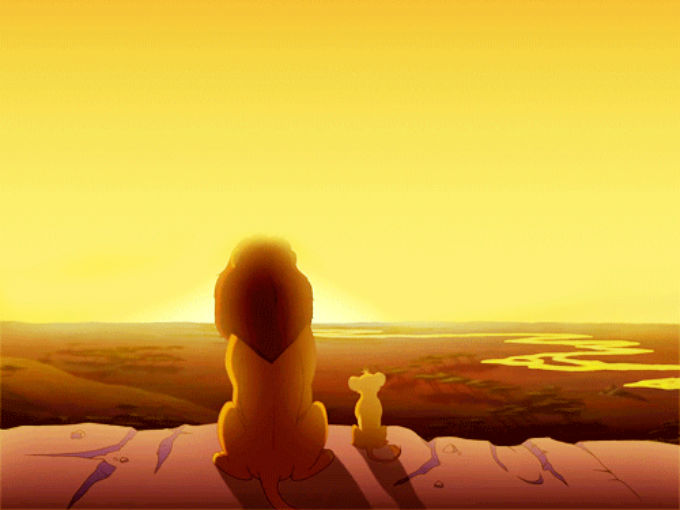
Hello everybody! I'm back with round 7 of ranking Disney movies. Just a reminder this is part of a series where I critique every single Walt Disney Animation Studios film, and "rank" them on a number of things such as music, character development, etc. If you'd like to visit past rounds, you can do so by clicking the link(s) below:
Welcome to the second third of the Disney Renaissance! I must admit that I thoroughly enjoyed this round. In my opinion, this round represents Disney at their peak (or at least one of their peaks). There isn't a ton of new information for me to say about this age, since all of these movies are still technically part of the Disney Renaissance. But, there's a little information I can give you.
This round kicks off with The Lion King, probably one of the most well-known animated movies of all time, and the most successful movie made during the Disney Renaissance. In fact, The Lion King was the highest grossing animated film for nearly 20 years, until it was finally beaten by Toy Story 3, and 2013's Frozen. Also of note, The Lion King was technically Disney Animation Studios' first original story (although they did borrow themes from Hamlet, the characters and story are still original). After The Lion King came Pocahontas, which sadly did not do very well at the box office, and only received lukewarm reception from critics.
An interesting note is that Jeffrey Katzenberg, who was the third-in-command at Disney, and who was responsible for helping to lead the company during the troubled times of the 80's and during the early days of the Renaissance, left Disney after a vicious conflict between the other Disney executives. Katzenburg left shortly before Pocahontas was released, and went on to start what would become Disney's largest rival in Animated film--Dreamworks Animation. The Hunchback of Notre Dame was the last Disney movie to have his supervision, followed by Hercules in 1997. These movies performed better than Pocahontas, both financially and critically, but they didn't make quite as much money as earlier Disney Renaissance films, like Beauty and the Beast. It was at this time that some critics began to accuse Disney of getting stale, and overusing its familiar story elements.
I decided to name this age the "Epic Age" because I feel like what these movies may have lacked in financial explosiveness (besides Lion King), they made up for in artistic and thematic scope. Every one of these movies deals with a character whose actions have far-reaching consequences. Their journeys affect entire cultures and kingdoms, not just themselves. The emotional and physical stakes were generally higher in these movies, with many characters grappling with moral questions, past traumas, and truly difficult decisions. The earlier Disney Renaissance movies may have been more fun for kids, but I feel like these ones were more fun and engaging to watch as an adult.
To learn more about the use of scope used in the Disney Renaissance, you can watch this video: here
On to the rankings!
To learn more about the use of scope used in the Disney Renaissance, you can watch this video: here
On to the rankings!
1. Best Female Lead
Nala is a pretty decent character. During the first half of the movie, she’s a great companion to Simba, and is just as much fun to watch as he is. The two of them make a great pair of miscreants :D. And for the most part, they have almost an equal amount of screen time as cubs.
Nala even has a good character arc too. At first, Nala is just as irresponsible as Simba is. She joins in his revelry. However, after she grows up, she becomes the voice of reason. She’s the first person to remind him of who he is, and of his responsibilities. Like Mufasa did before her, Nala sees the king inside of Simba, and does all that she can to help him live up to his potential. In a sense, that makes her the spiritual heir of Mufasa’s character, which is pretty cool.
3rd Place: Esmeralda (The Hunchback of Notre Dame)
-candles.jpg)
Esmeralda is a very cool character. She’s very brave
and passionate about her values and beliefs. In one of her very first scenes,
we see her essentially being a freedom fighter, rebelling against the corrupt government.
She fervently believes that there is hope for her people, and that they deserve
justice, and she’s not afraid to back down from this belief. Even when Frollo
threatens her with her life, she refuses to cave in or reject her beliefs. She’s
definitely a martyr figure.
Esmeralda is also fervent in lifting up the down
trodden. She’s the very first person to show kindness to Quasimodo (unless you
count the talking gargoyles who may just be Quasimodo’s hallucinations), even
after she discovers his deformities. She bravely stands up for him even when
everyone else around her stood against her. Her bravery and compassion was so
great that it even inspired Phoebes to become Quasimodo’s friend.
The one criticism I
do have about her character though is that she kind of leads Quasimodo on a
little, only to break his heart in a very sudden way. At the beginning of the
movie, she talks about coming to visit him again, and then even kisses him.
Then, next time he sees her, she basically makes out with Phoebes like two feet
in front of him. I know that this is a relatively small thing in the end, but
it still kind of left a bad taste in my mouth. Despite this one flaw though,
Esmeralda is still a very excellent character.
2nd Place: Megara/Meg (Hercules)
Man, this round has so many great female lead
characters, I wish I could give them all first place. Meg, like many of the
female leads this round, is pretty unique for a Disney character. The basic theme
of the movie is that true heroes are measured not by their strength or fame,
but by the measure of their heart. Going along with this theme, Meg is just as
much a hero as Hercules is. Sure, she struggles with different conflicts than
he does, but in the end, her heart is just as powerful as his is.
The thing that I love about Meg is that she represents
a group of women who often don’t feel powerful or heroic: those who have been
deeply hurt or betrayed by the ones they love. In particular, she represents
women who have been harmed or betrayed by the men they loved. Meg has suffered
through incredible pain, pain which has left her feeling worthless, unwanted,
and alone. She builds up a wall of coldness and cynicism around her heart
because she believes, “it’s better to be alone so that nobody can hurt you”.
Deep down though, Meg isn’t really cold or cynical, in fact, she secretly hopes
that she’ll find healing and hope, and be truly loved someday.
This is the reason why I chose to use this image for
Meg, which emphasizes this deeper, inner part of her, rather than choosing one
of the million pictures of her being cynical or snide. This inner desire for
freedom and hope is what motivates her to do the heroic things she does in the
movie. In the end, she sacrifices herself, and actually dies, to save the life of the person she’s come to truly love. This
demonstrates the inner heroism that it is in the hearts of those who have been
oppressed, or betrayed. While the world may see them as cold or anti-social, inside,
they’re really heroes just waiting to be called to action.

I really liked Pocahontas as a main protagonist, and I
feel like she’s one of Disney’s strongest characters yet. Pocahontas is interesting
as a protagonist in that she doesn’t really have a character arc of her own
during the movie. Other characters change and have arcs, but Pocahontas herself
remains virtually unchanged. Usually, I would say this is a case of bad
character writing, however, for Pocahontas, it doesn’t feel that way. This is
because she has what is known as a “flat character arc”.
Most character arcs are “positive change character
arcs”. This means that the movie starts with the protagonist believing a lie
about themselves or about the world (example: Simba believes that he will never
measure up to his father). The character then grows throughout the movie to
learn and accept the truth about themselves or the world.
With a flat character
arc, the movie starts with the protagonist believing in a specific truth rather than a lie, and the movie
is spent changing the rest of the characters to accept this truth that the
protagonist believes in. Boiled down, most character arcs change the character
to fit the world, but flat character arcs change the world to fit the character
or the character’s beliefs. This is kind of like real-world figures such as
Martin Luther King Jr. or Abraham Lincoln who led their worlds to change.
Pocahontas starts the
movie believing that the easiest path, or “smoothest course”, isn’t always the
right choice, and that sometimes, the harder path is the right one. This is
demonstrated in her willingness to seek peace with the English settlers, rather
than react to them with violence and anger, as her people chose to do (and as
the settlers chose to do as well). As she interacts with other characters, they
begin to change to fit her world view. John Smith’s perception of the Powhatans
changes because of her interactions with him. And then, she manages to change
the views of both her entire tribe and the English settlers (minus Ratcliffe). Pocahontas represents a spiritual, altruistic philosophy of virtue and balance, whereas the other characters mainly represent secular philosophies such as tradition, or expansionism. It is her unwavering actions and beliefs that transform the other characters' philosophies into more balanced, healthy ones. She doesn't impose balance upon the world through her own actions, but rather, the world is inspired to bring balance to itself because of her actions. Looking at her from this perspective, Pocahontas is essentially a Messianic figure/symbol.
2. Best Male Lead
That being said, John Smith does a fairly good job at
doing what non-protagonists are supposed to do: emphasize and point out
strengths and weaknesses of the protagonist. John Smith early on demonstrates a
flawed world view—the view that particular groups of people (namely, his group) are fundamentally “better”
than others. This is expressed in the way he sees Pocahontas’ people as
“savages” and focusing on how to fight them or “fix” them. This is in stark
contrast to Pocahontas’ world view—which views human beings in a more
egalitarian way. Once he is exposed to Pocahontas’ view, he begins to adopt it,
and tries to convince others to adopt it as well.
3rd Place: Hercules (Hercules)

"Honey, I think you mean HUNK-ules!"
What she really should have said was "HERA-cles" because technically he's called "Heracles" in the Greek myth, "Hercules" is his Roman name. Though I guess "Hercules" rolls off the tongue better than "Heracles" does. Still, they call everyone else by their Greek names, so it's kind of weird that he's the only one with a Roman name.
Anyway. So, besides having a Gospel choir theme song, Hercules is pretty much Superman. He's a strong blockhead, but he's a nice strong blockhead. I suppose they also kinda try to make us feel sorry for him by making the other Greeks mean to him, but it just kind of falls flat in my opinion, and doesn't really make sense. Why the heck would the other Greeks be mean to him if he clearly could snap them in half like a pencil? You'd think they'd have a stronger sense of self-preservation than that. But it's also weird because he already demonstrates in the movie that he wants to help people, so why not make that his central motivation rather than trying to fit in?
He makes a lot more sense during the second half of the movie (pretty much when Meg shows up). As the movie so non-subtly points out, he learns what it means to become a true hero. It's kind of cool that Meg ended up being the one who taught him true heroism, as she was the one who sacrificed herself for him first. It just goes to show how much a man can learn when he lets a woman influence and teach him. Meg is the true hero of the film, and the best thing about Hercules is that he himself would be the first one to admit it.
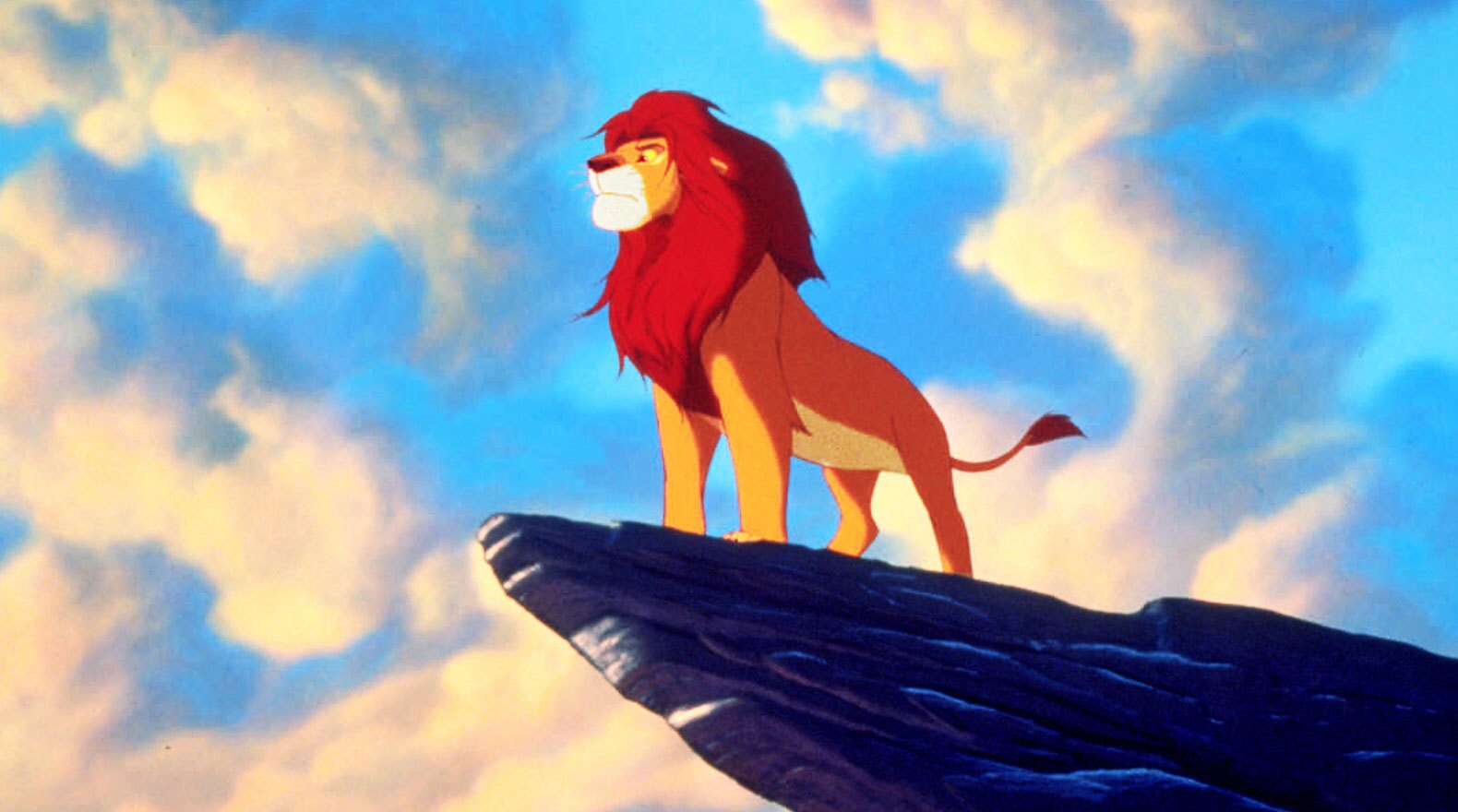
I used to think that Simba was just annoying—like a
male Ariel. Since I like Ariel a lot better now, I suppose it makes sense that
I like Simba a lot better too. Even when he’s a kid, Simba doesn’t really annoy
me that much anymore. I mean, sure, he’s a little impulsive and egocentric as a
kid, but what little kid isn’t to some degree? In fact, I found myself enjoying
watching him and Nala getting into mischief this time around.
The best part about Simba’s character is the emotional
journey that he goes through. We see him go through unimaginable pain, get
stuck in the grieving process, and then learn how to overcome his grief. First
off, he witnesses the death of his father (who was one of the best Disney
parents ever by the way) and is then
convinced that his father’s death was his fault. He then lives with that burden
for the rest of his childhood, through adolescence, and into emerging
adulthood. He gets stuck in the cycle of grief, going from denial, depression,
then back to denial. He convinces himself that nobody really needs him, and
that the world is better off without him.
Simba feels lost without his father, and all of the
above grief and trauma leave him feeling like it’s impossible for him to ever
be the person his father wanted him to be. When Simba is still a cub, there’s a
scene where Simba steps into one of his father’s footprints and looks down at
how small his own paw is in comparison—a foreshadowing of his future feelings
of insignificance and failure.
All of this would be very depressing if he didn’t
overcome his grief in the end. It takes several tries for Simba to overcome his
self-loathing and depression. Nala, Rafiki, and eventually Mufasa all speak to
him in order to convince him to remember his worth and take his rightful place
as king. Simba eventually listens to them and does take his rightful place as
his father’s heir. In a final scene filled with heavy symbolism, Simba stands
on pride rock in the same pose as his father does at the beginning of the movie,
to show just how far he has come.
Winner: Quasimodo (The Hunchback of Notre Dame)


Quick question. If Quasimodo’s parents are both
dark-skinned, dark-haired gypsies, then how come he’s white-skinned and
red-haired? Seems a little fishy…
Besides this ethnic dysphoria, Quasimodo is an
outstanding character. He’s truly unique among male Disney heroes. Whereas
other male Disney heroes are strong, masculine, and need to learn responsibility,
Quasimodo is vulnerable, emotional, passionate, and needs to learn how to love
himself. He’s a role model that who I feel men can look up to, especially men
who feel unsure of themselves, or feel like they don’t fit the “ideal man” stereotype.
Quasimodo demonstrates that it is traits such as compassion, kindness, and
moral bravery that make a hero, and not necessarily strength or power.
Quasimodo is also a perfect counter to his antagonist,
Frollo. In particular, both characters symbolize opposing ideas of what it
means to be a man. Quasimodo represents the character traits that make a man a
hero: compassion, respect, virtue, and humility. Conversely, Frollo symbolizes
the character traits that can turn a man into a villain: dominance, lust,
pride, and amorality. It’s interesting to note that Frollo fits the “manly”
stereotype more than Quasimodo does, which I think is done on purpose. In this
sense, Quasimodo’s conflict with Frollo could be seen as a parallel to the
conflict many men have with trying to conform to what society “expects” them to
be. The world demands that a man stay locked away in a fortress of apathy,
emotional distance, and masculinity, or else suffer the “calumny and consternation”
of others. However, if a man steps outside of this “fortress”, he will find
that being a man isn’t about locking oneself away, but rather opening oneself
up. And he will also find that by opening himself up, by stepping outside of
his comfort zone, he can help save others.
3. Best Villain/Antagonist

Ratcliffe isn’t really a bad
villain per se, I mean, he does a pretty good job of being Pocahontas’ opposite
(he’s selfish, insincere, and demonstrates an absolute lack of compassion). The
way he’s able to manipulate the settlers is also a pretty dark reflection of
Pocahontas’ own ability to influence others. Compared to the other villains in
this round though…he pretty much pales in comparison. Although he can be
sinister, and dark, he usually just comes across as petty and ridiculously
self-absorbed.
3rd Place: Scar (The Lion King)

“Oh Scar, it’s just you. We thought it was somebody
important!”
Now that I think about it, this one line pretty much
sums up Scar’s psychological profile. His whole life he’s lived in Mufasa’s
shadow, and then, he’s forced to live in Simba’s shadow. So, he rebels against
both of them, and tries to make himself the important one--ironically putting
the whole kingdom, including himself,
in the shadow of Mufasa’s death.
Anyway, Scar definitely qualifies as one of the most
memorable Disney villains. First of all, Jeremy Irons does a phenomenal job of voicing him—giving him
that sly, dark voice we all love. This is put to great effect when he sings “Be
Prepared”, which is a Disney villain classic.
Scar doesn’t just look and sound like a good villain,
he is a good villain. His most
villainous quality is his absolute cruelty. The suffering that he makes Simba
go through alone is just horrifying. First of all, he manipulates him into
going to the elephant graveyard, where he and Nala nearly get torn to shreds by
hyenas. Then, he murders Mufasa, forcing Simba to watch as his father falls to
his death and gets stampeded by wildebeests—leading to what has to be one of
the most heart wrenching scenes in Disney history. Then, to top it all off, he convinces Simba that his father’s death
was all his fault. He convinces him that his family will hate him, and that he
is to blame for everything. By the time he’s done manipulating and traumatizing
Simba, the audience is just absolutely ready for Scar to get his comeuppance.
And get it he does.
So sorry for all the Scar aficionados out there. If he was going up against the likes of just Ratcliffe, then he'd definitely be in first place. However, he's also going up against two of the other greatest Disney villains ever...
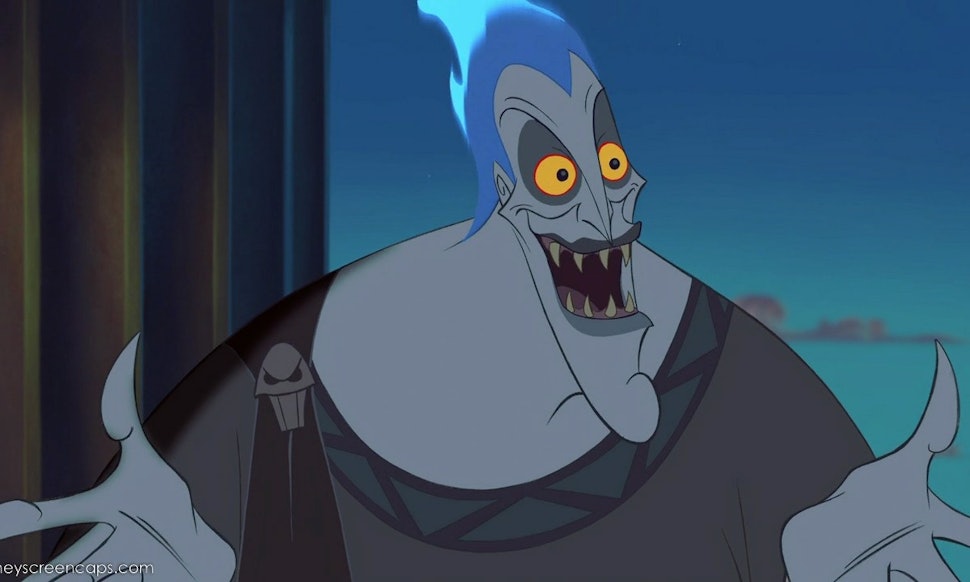
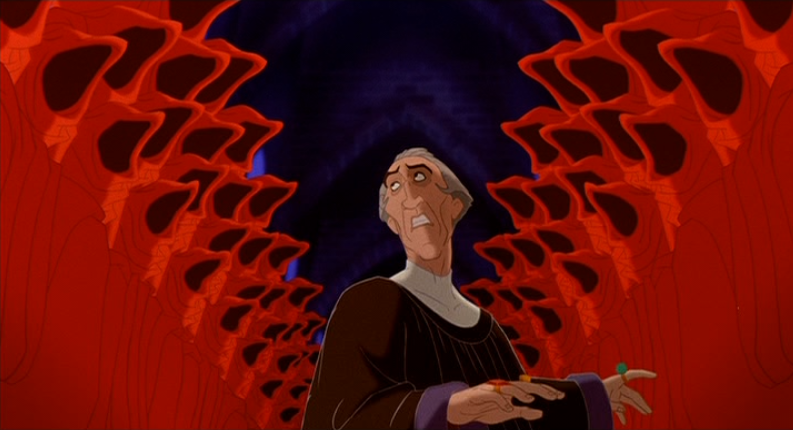
Frollo is one of the most intense villains in any Disney movie ever. The very first scene we see him in does a pretty good job of demonstrating this. He murders a young mother, nearly drowns a baby, and then precedes to raise said baby in the cruelest way imaginable (why did the Archdeacon think it was a good idea to have the guy who almost drowned a baby become the adopted father of that baby?) Then, as the movie progresses, we see him sexually harass an innocent woman, allow his adopted son to be humiliated and tortured in town square, try to burn a family alive in their own house, and attempt genocide. And the most infuriating thing is that the whole time, he pretty much believes he’s in the right.
So sorry for all the Scar aficionados out there. If he was going up against the likes of just Ratcliffe, then he'd definitely be in first place. However, he's also going up against two of the other greatest Disney villains ever...
2nd Place: Hades (Hercules)

First of all, let me tell you what Hades is not. He is not a very good representation of the Hades/Pluto from the original Greek/Roman myths. In the original mythology, Hades wasn't really evil, he was just the God of something that most people didn't really like--death. Sure, he did some pretty selfish things, but so did literally every other Greek/Roman God, including Zeus, who is basically an incestual, mass-murderer in the original myths. Hades is downright chummy compared to most of the other Greek and Roman gods.
Anyway, what Hades is is absolutely hilarious and fun to watch. Although he didn't win the best villain award for this round, he definitely wins the sassiest villain award. The actor for Hades does a perfect million-miles-an-hour delivery of his lines. Hades has that quirky, lovable sarcasm that makes him feel like one of your best friends--you know, the snarky one that you probably shouldn't listen to most of the time.
Anyway, Hades is placed so high not only for his charisma and great character performance, but also for how well relatable of a villain he is. All of us have met people who speak a million miles an hour, and who are full of flashy smiles, all the while looking for your weaknesses that they can exploit. When they find your weakness, they strike. And not only do they strike your weakness, they smile at you and offer you a "deal you just can't refuse" while they do it. That's Hades. He's like an evil door to door salesman from Hell...which I guess is pretty much every door to door salesman, right?
Speaking of Hell...
Anyway, Hades is placed so high not only for his charisma and great character performance, but also for how well relatable of a villain he is. All of us have met people who speak a million miles an hour, and who are full of flashy smiles, all the while looking for your weaknesses that they can exploit. When they find your weakness, they strike. And not only do they strike your weakness, they smile at you and offer you a "deal you just can't refuse" while they do it. That's Hades. He's like an evil door to door salesman from Hell...which I guess is pretty much every door to door salesman, right?
Speaking of Hell...
Winner: Claude Frollo (The Hunchback of Notre Dame)

Frollo is one of the most intense villains in any Disney movie ever. The very first scene we see him in does a pretty good job of demonstrating this. He murders a young mother, nearly drowns a baby, and then precedes to raise said baby in the cruelest way imaginable (why did the Archdeacon think it was a good idea to have the guy who almost drowned a baby become the adopted father of that baby?) Then, as the movie progresses, we see him sexually harass an innocent woman, allow his adopted son to be humiliated and tortured in town square, try to burn a family alive in their own house, and attempt genocide. And the most infuriating thing is that the whole time, he pretty much believes he’s in the right.
Frollo is just the perfect example of how power can corrupt
people. Throughout the movie, we see that Frollo is obsessed with control, and
trying to impose his will upon the city and its inhabitants. Whenever anyone
opposes him, even in the slightest thing, he lashes out at them in terrifying
rage. His tenacity is also horrifying. When Frollo sets his mind to do
something, he won’t rest until he sees it accomplished—even if the results
prove disastrous. His tenacity and lust for control take admirable traits—Justice
and Order—and twist them to the extreme,
sacrificing the lives of his own people to satiate his madness.
Perhaps the most intense thing about Frollo though is that he is the perfect representation of the misery and anguish caused by sin. First of all, there's the obvious Hell/damnation imagery that is attached to him. He falls to his death into a lake of molten brass (at least that's what I think it is...), he sets all of Paris on fire, and...oh yeah, he literally spends three minutes singing a song about the fires of Hell. The thing about Frollo is that he doesn't take any delight in this Hellish imagery, like other villains might. Like most Catholics in 14th Century France would be, he's horrified of Hell and Damnation. As he sings about his lust for Esmeralda and plots her demise, he catches a glimpse of what he's becoming, and it seems to horrify him. He pleads, "God have mercy on me", and not in some perfunctory way, but with genuine horror and trepidation in his voice. Unfortunately however, this fear isn't enough to jog some sense to him, and he ends up embracing his wickedness and iniquity, boldly stating at the end of his song, "But she will be mine or she will burn!" Thus sealing his own fate, knowing full well that he is selling his soul to the Devil.
He succeeds at doing all of this I might add while keeping the movie rated "G".
4th Place: Philoctetes/Phil (Hercules)
Perhaps the most intense thing about Frollo though is that he is the perfect representation of the misery and anguish caused by sin. First of all, there's the obvious Hell/damnation imagery that is attached to him. He falls to his death into a lake of molten brass (at least that's what I think it is...), he sets all of Paris on fire, and...oh yeah, he literally spends three minutes singing a song about the fires of Hell. The thing about Frollo is that he doesn't take any delight in this Hellish imagery, like other villains might. Like most Catholics in 14th Century France would be, he's horrified of Hell and Damnation. As he sings about his lust for Esmeralda and plots her demise, he catches a glimpse of what he's becoming, and it seems to horrify him. He pleads, "God have mercy on me", and not in some perfunctory way, but with genuine horror and trepidation in his voice. Unfortunately however, this fear isn't enough to jog some sense to him, and he ends up embracing his wickedness and iniquity, boldly stating at the end of his song, "But she will be mine or she will burn!" Thus sealing his own fate, knowing full well that he is selling his soul to the Devil.
He succeeds at doing all of this I might add while keeping the movie rated "G".
4. Best Side/Supporting Character(s)
4th Place: Philoctetes/Phil (Hercules)
Geesh, I did not care for this guy this time around. Phil is basically a goat, personality and all. He's annoying, obnoxious, and quite frankly gets on my nerves. He gripes about everything, only stopping once in a while to say something mildly supportive. He's also a huge hypocrite, getting angry at Hercules for falling in love with Meg, when he himself is one of the biggest womanizers around. He's kind of just like a middle-aged, fat, angry, armchair quarterback who groans about the glory days back when he was on the Junior High football team, and how he would have made it into the NFL if wasn't for "hurting his knee Freshman year". That's basically Phil...moving on.
3rd Place: Meeko (Pocahontas)

Aw, Meeko. He’s arguably one of the most entertaining
parts of this movie. He’s definitely comic relief, and he gets used a lot.
However, because he doesn’t actually talk, his antics feel a little bit fresher,
and less predictable. He’s not very deep or anything, but he’s definitely a
welcome addition to the movie.
2nd Place: Timon & Pumbaa (The Lion King)
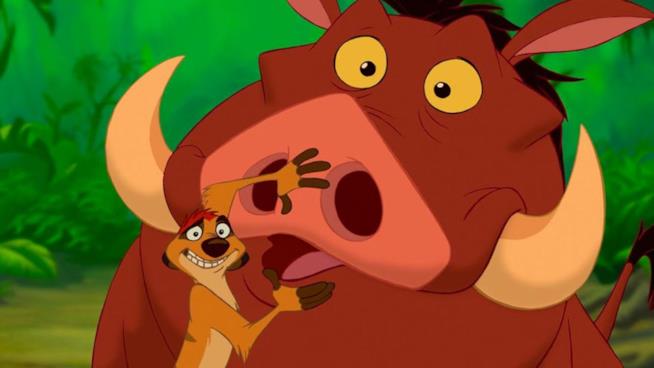
So, if Simba is symbolic of children who go through
terrible trauma and try to run away from their pain, then Timon and Pumbaa are
symbolic of drug dealers. Think about it, they offer him a solution that will “solve
all your problems” and will give him “no worries”. Then, they take him in and
turn him into a member of their own gang, helping them try and spread “Hakuna
Matata” to others…
So, now that I’ve ruined your childhood, let’s talk
about the good traits of Timon and Pumbaa :-) . Timon and Pumbaa basically fit
into the comic relief category, which means there’s not a whole lot to them.
The thing about them though is that they aren’t introduced until halfway
through the movie, and show up at a time when the audience is praying for some
lighter tones. This means that they work
as comic relief characters—because they actually provide relief. They aren’t like other comic relief characters that are
there for the whole movie stealing the show from the main characters. The movie
uses them sparingly, which keeps them from getting stale.
5. Best Music/Songs
6. Best Romance
Winner: Phoebus (The Hunchback of Notre Dame)
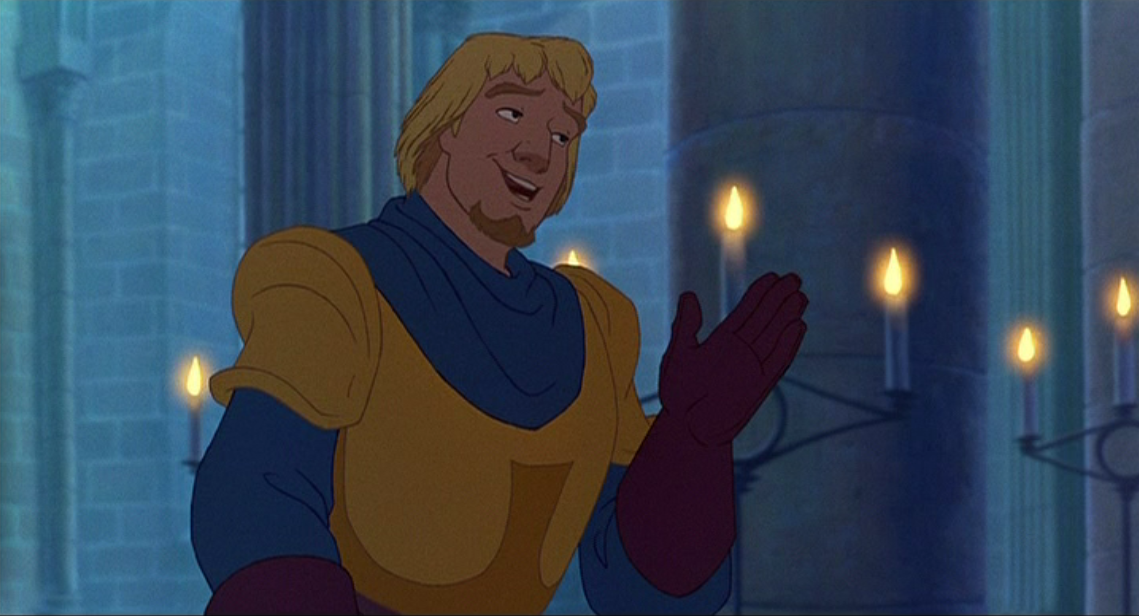

“Hey isn’t that uh, Feeble?”
“Doofus”
“Phoebus!”
Phoebus is a pretty cool guy. First of all, I really
like his armor’s design. It just looks so cool. Besides just looking cool,
Phoebus is also unfathomably kind and generous for a 14th century
French military officer (he was an absolute jerk
in the actual book). It’s so interesting that Phoebus is just a side character
in this movie, since he plays the role that the hero of the story usually
plays.
It’s interesting to
note that Phoebus is also a pivotal character for Quasimodo’s character arc.
Esmeralda of course was the first person to really show any kindness and
respect to Quasimodo, but Phoebus was the second. With Esmeralda and Phoebus
both being the first man and woman to show Quasimodo kindness, they sort of
become like “parents” to him in a way (which I guess is fitting in a way since
they get married at the end of the movie). Phoebus and Esmeralda together bring
Quasimodo into the light of day, as a mother or father would.
5. Best Music/Songs
4th Place: Hercules
The music in this movie is pretty good, I mean, every movie in this round has awesome music. I guess I just don't really like this one's music as much because it seems to be a little all over the place. The songs just don't seem to support the central themes of the movie. They're fun, but don't really add anything to the overall movie.
3rd Place: Pocahontas
The music in this movie is pretty decent, and can be downright awesome
at times. “Mine, mine, mine” and “steady as the beating drum” are just kind of
there. “Paint with all the colors of the wind” is basically the point of the
whole movie—being able to see the world from others’ perspectives and seeing
the good in them. “Just around the river bend” does an excellent job of
showcasing just how future oriented and innovative Pocahontas is as a
character. “Savages” adds a very deep emotional core to the movie’s climax and
does a great job of tying together the conflicts between the Powhatans and the
settlers.
2nd Place: The Lion King
I really loved the music from this movie. Every song just feels like it
belongs. I even liked the Elton John songs (which most people seem to dislike
for some reason). “Be Prepared” is a Disney villain staple, “The Circle of
Life” makes for one of the greatest intros ever, and who can forget “Hakuna
Matata”, the absolutely essential comic relief to wash the tears from our eyes
after Mufasa’s death. Surprisingly, the best part for me was the music that
played during the wildebeest stampede. The fear and suspense that it captures
is just awesome, and really immerses you in that scene.
Winner: The Hunchback of Notre Dame
Okay, how could I not
make this movie’s music the winner? Just listen to the first song, and you’ll
realize that this music is something incredibly unique for a Disney film. These
songs are chock-full of emotional depth and humanity (well, except for the
comic relief songs). “The Bells of Notre Dame” is just a musical bomb-shell.
“God help the outcasts” is an absolutely beautiful song as well, which adds so
much to the movie’s meaning. “Hellfire/Heaven’s Light” is the best example of
musical juxtaposition I’ve ever seen (And possibly one of the best Disney villain songs ever). The
only song I don’t care for is “A guy like you”, which seems to serve no other
purpose than to remind you that the obnoxious (maybe hallucinatory?) gargoyles
are still around.
6. Best Romance
4th Place: Pocahontas & John Smith (Pocahontas)
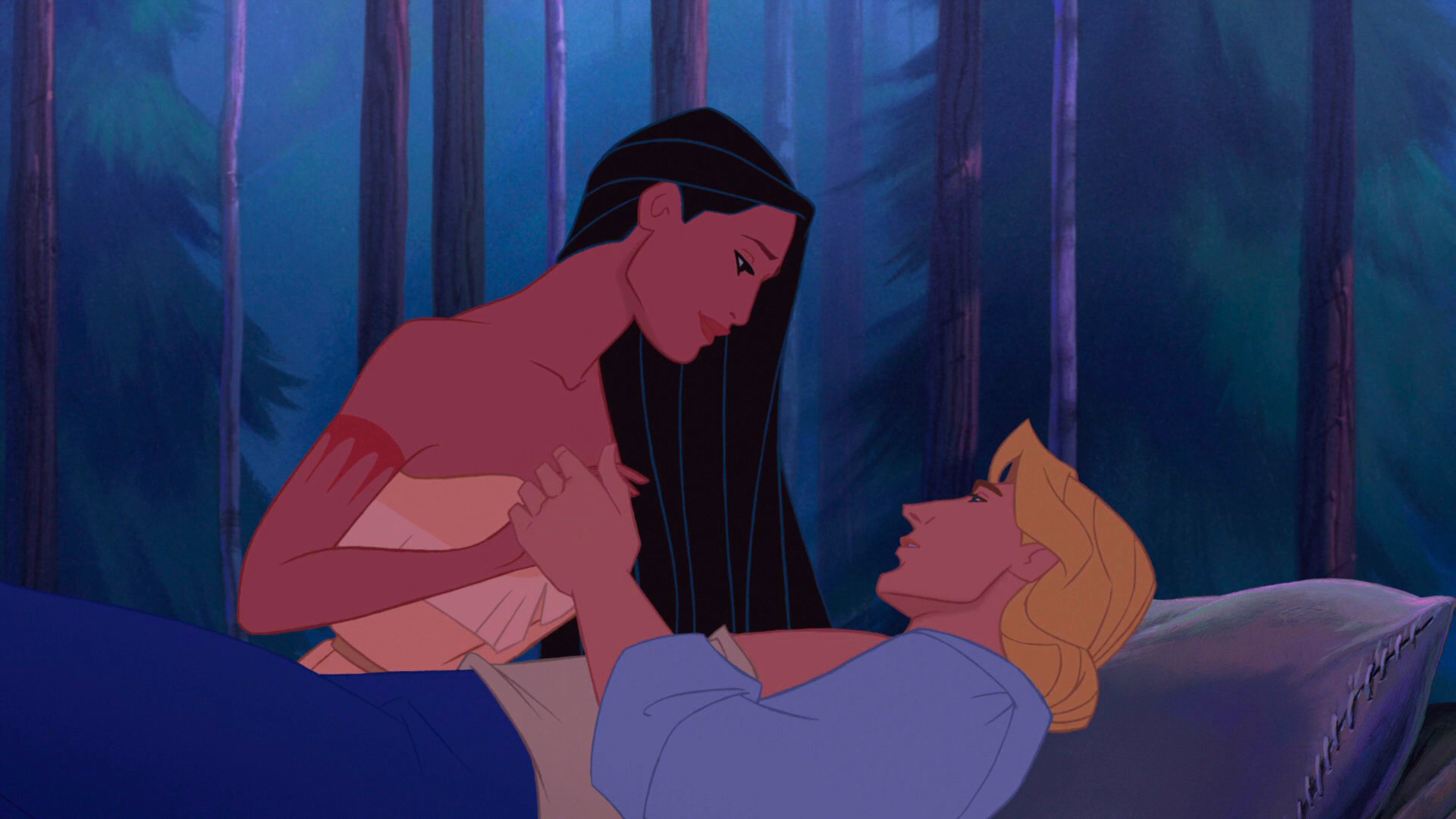

This relationship wasn’t as bad as I used to think it was. It does have its merits. John Smith is
inspired by Pocahontas’ tenacious ability to see good in others and the world
and tries to emulate that in his own way. I think that’s a pretty neat aspect
of their relationship. The only problem though is that these two have next to
no chemistry. Like, it’s hard to understand why exactly Pocahontas falls in
love with John. Sure, she can see the good in him, but she sees the good in
everyone. The movie doesn’t really say or give any indication as to what it is
about John Smith that draws Pocahontas to him, other than the fact that he’s
something new. And yes, there are touching moments between them (like when John
Smith says he’d rather die having met Pocahontas than live a hundred lifetimes
without ever knowing her), but without having any real chemistry between them,
those moments feel a little empty and underused.
3rd Place: Simba & Nala (The Lion King)
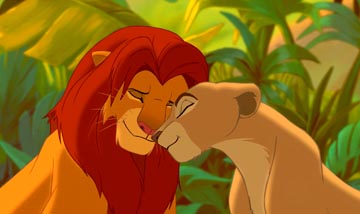
This romance is okay. The biggest challenge for this
relationship is that it doesn’t get much screen time. We see them together for
a few minutes, but then the movie seems to be in a rush to move things along.
Being that this movie was targeted at the young boy demographic, I can see why
they chose to cut back on the romance. But still, couldn’t they have given them
a few more minutes together?
What we do get to see
is nice in my opinion, they have some great chemistry together. The most notable thing to me is that Nala persistently
tries her best to help Simba live up to his potential. It's her belief in him that starts the process of his healing. It’s also cute to watch them
during the “Can you feel the love tonight” song, as they reunite after being
apart for so long. It was also cool seeing them team up to go save Pride Rock. Their relationship has some wonderful aspects to it, I just kind of wish we’d seen more of them together.

2nd Place: Esmeralda & Phoebes (The Hunchback of Notre Dame)

Gosh, you two. Get a room (seriously though, Quasimodo is just right there...)
The hard thing too is
that Phoebus isn’t a jerk, so it’s hard to be mad at Esmeralda for being with
him. He did his best to save Esmeralda’s life, risked his own life to defy
Frollo and rescue a family from a burning building, and went on to help the
people of Paris rise up against Frollo’s tyranny. When you look at all of that
together, it’s not hard to see why Esmeralda likes him. In the end, the fact
that Phoebus and Esmeralda end up together helps Quasimodo learn acceptance, as
he willingly joins their hands together and smiles as they kiss at the end.
Sometimes love doesn’t work out the way you want it to, but that doesn’t necessarily
have to be a bad thing.

*Sigh*. So, I both really love, and really hate this
relationship at the same time. I love it because Phoebus and Esmeralda go well
together, and their relationship makes a lot of sense. I hate it because it
also sends so many mixed messages to the audience. The biggest issue I have
with it is that at the beginning of the movie it looks like Quasimodo, a
disenfranchised, physically deformed minority is going to end up finding true
love, but then instead, the handsome, stereotypical knight in shining armor
finds it instead.
I understand that some people praise this relationship
because it shows that the hero doesn’t always get the girl, and that men
shouldn’t see women as prizes for good behavior. I get that, and I respect that
view. I think it’s an important message to deliver. It’s just so painful to
watch the message come across at Quasimodo’s expense. Everyone’s rooting for
Quasimodo to be brave and tell Esmeralda how he feels, which makes it all the
more crushing when he sees Phoebus and Esmeralda kiss each other. We literally
just got done watching him sing about how Esmeralda was an angel to him, and
how his feelings for her were like “heaven’s light”, and then we’re forced to
watch as his dreams get crushed and obliterated.
Winner: Hercules & Meg (Hercules)

There are a few places in which Hercules stuttered a bit, but one of the things they got absolutely
right was this romance. The love between these two is just so natural, and
meaningful, it’s arguably the best part of the whole movie. The thing that
makes this relationship so great is that it is deeply meaningful and impactful
for both Hercules and Meg.
Hercules wasn’t really much of a hero before he met
Meg. True, he had good intentions, but it was Meg who helped him to put his
heart in the right place. She helped him to forget about what everyone else
thought about him and helped him realize that it was far more important to mean
the world to one person than it was to have the whole world accept him. Not
only did his relationship with Meg teach him about acceptance, but it also
helped him learn forgiveness. Hercules was seriously hurt when he found out Meg
had been working for Hades, and this hurt led him into a spiral of depression
and grief. However, when Meg sacrificed herself to save him, Hercules learned
to overcome the pain she had caused him and see her true love for him instead.
That’s how relationships work in the real world. Sometimes we hurt each other.
But, forgiveness will always be there to heal us, and help us remember our love
for each other.
Meg was also changed by this relationship. Before she
met Hercules, she had been lied to, abused, and betrayed by men, and she had
sworn off ever falling in love again. There are many people in this world, men
and women, who have made similar promises to themselves. Like Meg, they believe
that a life of loneliness is better than having the chance of getting hurt.
However, as Meg began to let her guard down, and let herself be more
vulnerable, she discovered that in opening herself up to pain, she also opened
herself up to love, hope, and healing. Sometimes that’s the way a relationship
is, we need to open ourselves up and be vulnerable. It will almost certainly be
terrifying, but it is the only way for us to find true peace and security.
7. Best Overall
4th Place: Pocahontas

I thoroughly enjoyed all of the movies in this round, so it's really hard to say which ones are better or worse. I would say that I enjoyed Pocahontas overall the least. To be honest, It's not that bad, it's a solid 7/10 in my book. The biggest problem I have with it is that some of its characters just aren't as interesting as the characters in the other movies. The male lead and the villain are both kind of boring. I know, It's kind of nit-picky--but when every movie in the round is so good, that's kind of what I have to resort to :).
3rd Place: Hercules

I really enjoy this movie, though I think it suffers a bit from the same problem that Aladdin had. That is, it focuses a little too much on comedy and pop-culture than it does on the heart of the film. I would have liked to have seen more development of the characters. I also kind of have a bone to pick with this movie of its wildly inaccurate portrayal of Greek Gods and Myths (though, I understand the fact that most Greek myths aren't "G" rated...)
Like Aladdin, this movie has some good heart to it, I just would have liked to have seen a little bit more of it.
2nd Place: The Lion King
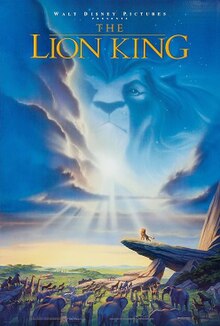
I honestly don't have any real complaints with this movie, other than that they don't give much time to Nala or her relationship with Simba. Other than that, this movie delivers pretty much everything you could want from a Disney film. It's got lovable characters, great music, and great themes about self-discovery and healing from trauma. Definitely deserves to be called a Disney classic.

I could live without the gargoyles, but everything else about this movie is pretty much perfect. All of the main characters are interesting, well developed and help present the overall themes of the movie in really cool ways. The music is Oscar worthy, and just absolutely soul-stirring. The villain is intense and powerful. This movie took a lot of risks, and it really pays off in my opinion.
***
Man, this round was really hard to do. With basically all four of these movies being so good, I've come to realize even more just how subjective these rankings really are. These really are just my opinion, no matter how I frame them. There are plenty of great arguments for Lion King being the best overall, or Esmeralda being the best female lead, and so on so forth. So if your opinions are different than mine, that's okay, because they're literally just as valid. Go ahead and share your ideas and opinions, I'd love to hear them :).
So, next round, I will be taking a look at the final part of the Disney Renaissance. I'll be watching Mulan, Tarzan, Dinosaur, and The Emperor's New Groove! I'm pretty excited to watch them, so stay tuned!
This week, the children's organization I want to highlight is Children's Miracle Network Hospitals.

***
Man, this round was really hard to do. With basically all four of these movies being so good, I've come to realize even more just how subjective these rankings really are. These really are just my opinion, no matter how I frame them. There are plenty of great arguments for Lion King being the best overall, or Esmeralda being the best female lead, and so on so forth. So if your opinions are different than mine, that's okay, because they're literally just as valid. Go ahead and share your ideas and opinions, I'd love to hear them :).
So, next round, I will be taking a look at the final part of the Disney Renaissance. I'll be watching Mulan, Tarzan, Dinosaur, and The Emperor's New Groove! I'm pretty excited to watch them, so stay tuned!
This week, the children's organization I want to highlight is Children's Miracle Network Hospitals.
According to their Wikipedia article, CMNH is "a North American non-profit organization that raises funds for children's hospitals, medical research, and community awareness of children's health issues". They are based in Salt Lake City, Utah. So far they've helped raise over 4 Billion dollars for children's hospitals!
When you visit the link above, the website should automatically link you to the closest CMNH partnered hospital in your area, which will allow you to donate directly to that hospital if you choose.






Comments
Post a Comment